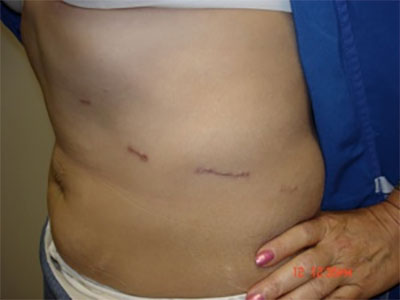
The patient pictured above is about 1 week post-op following a transabdominal laparoscopic adrenalectomy for a large pheochromocytoma. Four small incisions are seen in the left upper abdomen. The longer incision is where the tumor was removed. Laparoscopic adrenalectomy is the standard of care for most adrenal tumors. It hurts less and the time in the hospital and overall recovery is dramatically less than with traditional opened techniques. Laparoscopic adrenalectomy is appropriate for benign adrenal tumors and small malignant tumors. Laparoscopic adrenalectomy can be performed through the transabdominal (transperitoneal) or posterior retroperitoneal approaches.
For a transabdominal laparoscopic adrenalectomy, the patient is brought to the operating room and a general anesthetic is given. The patient is then placed on their side – left side up for left adrenal tumors and right side up for a right adrenalectomy. Generally, four ports are placed along the rib margin about 3 inches apart for the right, three or four ports on the left. On the left, the spleen and pancreas are elevated away from the adrenal gland, the vein coming from the gland is tied off and the gland is separated from the surrounding tissues and kidney. The tumor is placed in a sterile bag and then removed. In large tumors the exit incision may have to be slightly enlarged to remove the specimen. On the right, the liver is elevated away and again the large vein leaving the gland is ligated and the tumor is removed. The procedure last 1 1/2 to 2 1/2 hours depending on the size of the tumor and the size of the patient. The patient spends about an hour in the recovery room and then is admitted to a regular floor bed for observation over night. If the patient feels well the next day they are discharged. Pheochromocytomas are handled slightly differently. After resection of a pheochromocytoma, the cardiovascular stimulation caused by the tumor resolves. However, the patients may still have some vascular instability, usually low blood pressure. For this reason, patients with pheochromocytomas that have been removed are observed in the intensive care unit over night. Once the patient is stable and feels well they are discharged, usually on post-op day 2 or 3.
For posterior retroperitoneal laparoscopic adrenalectomy, the patient will be placed in the prone (face down) position prior to surgery. Typically, three laparoscopic ports are placed below the ribs on either the right or the left side, depending on which side the tumor is located. The tumor is identified and separated from its blood vessels while preserving the important structures surrounding it. On the right side, this would include the right kidney, liver, and inferior vena cava. On the left side, this would include the left kidney and spleen. This approach has the benefit of avoiding entry into the abdominal cavity. This can avoid encountering adhesions formed from prior abdominal surgeries.
The incisions are then closed and the patient awakened and admitted for recovery. Pain from this operation is minimal and patients are often times ready to be discharged the following day. However, discharge from the hospital may depend on other tests for normalization of biochemical function if the mass was secreting too much hormone.
Patients are able to eat normally and perform normal non-athletic activity as their comfort level allows. The wounds are closed with skin glue and the patient may shower the first post-op day. Patients with office jobs usually return top work in 7-10 days. Those with physically demanding jobs return to work in 2-3 weeks. There is some discomfort with the operation. Most patients use narcotic based pain medication for about a week. The discomfort is substantially less than with open techniques. (See a video clip of a right adrenalectomy and a left adrenalectomy)
Patients with large tumor (> 10cm) derive less benefit from laparoscopic techniques and the risk of malignancy goes up substantially. The most important issues become adequate negative margins and safe removal of the tumor. In this situation standard open surgery is appropriate. With open surgery most patients are in the hospital 3-4 days and return to full activity is 4-6 weeks.
Over all the risk of surgery is small. The risks include cardiovascular risks of anesthesia. The risk of bleeding is real but very uncommon. Infection is very rare. The risk of a serious complication is about 2%. If patient safety or adequate resection are at issue we will not hesitate to convert to an open approach. Patients with pheochromocytomas have additional cardiovascular risks because of the over production of catecholamines. With adequate pre-op preparation this risk is minimized but there remains a small risk of complications related to cardiovascular instability including a risk of stroke or heart attack. We will discuss the preo-op preparation in detail on the pre-op care page.
